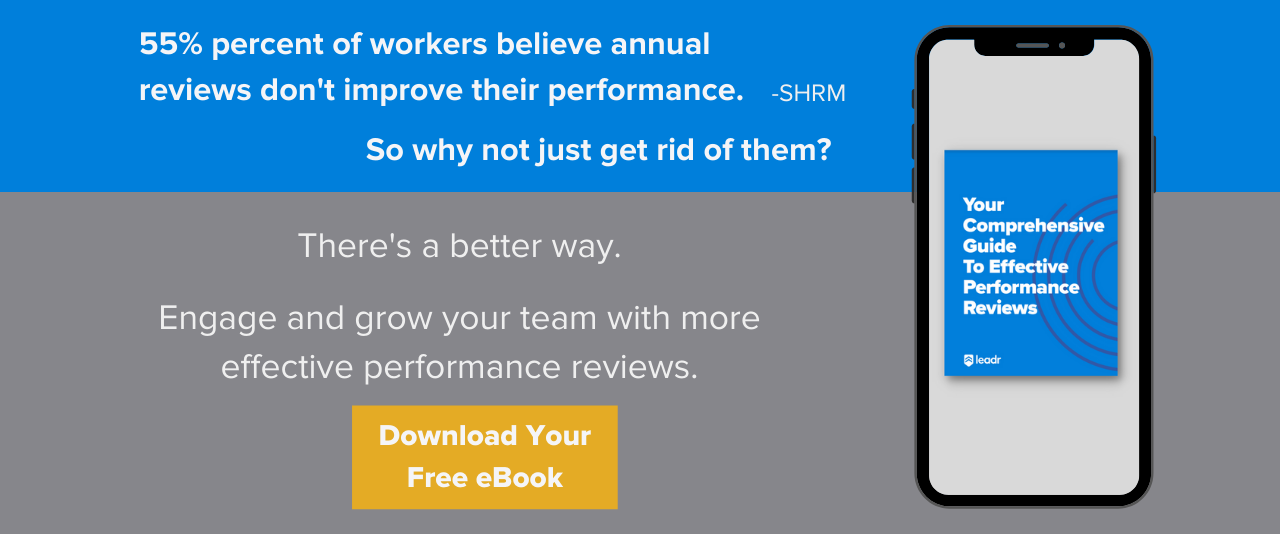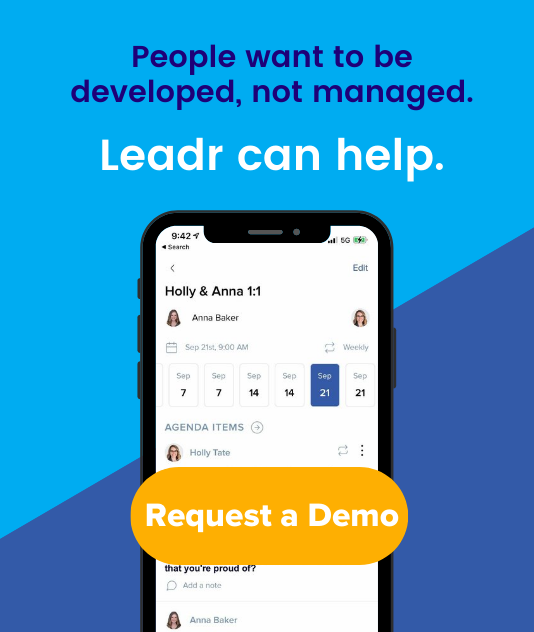4 Tips For Performance Reviews That Engage Remote Employees
It’s an exciting time to be a leader right now because today’s leaders are pioneering the path forward for what remote and hybrid work looks like.
According to the Harvard Business Review, 62% of employees believe working remotely positively impacts engagement, yet only 5% are likely to stay at their company long-term.
This tells us that while remote work is a viable solution, and one employees are seeking, leaders need to put effort into making remote employees feel like they’re a part of the mission if these employees are going to stick around.
Rather than allowing remote employees to have a second-rate employee experience, there are dozens of ways that you can (and should) engage remote workers on a cultural level that will help them feel more fulfilled and connected to their jobs and team members.
Let’s dive into one area in particular. Performance Reviews.
Providing Remote Employees With An Engaging Performance Review
Performance reviews tend to be a dreaded topic in the workplace. Leaders feel the need to critique their staff for an entire year’s worth of highs and lows and employees fear the uncertainty of outcomes the conversation may have. In a recent blog, we dive into the many ways traditional, yearly performance reviews just don’t worry anymore and how to make them more effective. Check that out here.
But the gist is that giving and receiving feedback should not be reserved for a once or twice-a-year conversation. Discussing performance, goal metrics, and status checks should be a familiar rhythm, especially when it comes to remote team members. However, it’s not as easy for remote staff to pop into your office and have meaningful conversations throughout the day, and it’s not as easy for you as a leader to gauge their investment in their role, so it’s critical to use this time to dive into the topics you discuss on a weekly basis with intentionality.
Here are four keys to an intentional performance review that will engage employees, remote or not:
1. Set clear expectations before the review
Nothing is worse than walking into a staff review wondering if your self-assessment will measure vastly different than your leader’s assessment of you. Even employees with stellar performance fear that their boss has saved all negative feedback for this conversation. Most people walk in wondering, what if my boss and I don’t align on my performance after all? And remote work leaves even more room for miscommunication and misalignment.
They’re not sitting in the office chatting with coworkers about their weekend or able to attend all of the fun team building events. It’s not as simple for them to pop in and ask clarifying questions or overhear other teams’ conversation in the break room. So, creating clarity prior to (and during) your performance review sets the tone for how connected they will feel to your organization moving forward.
With this in mind, set clear expectations upfront and be sure to communicate thoroughly ahead of time. Make sure your team members understand how they’ll be evaluated. This will help your team prepare calmly and confidently for the actual meeting versus fearing the unknown.
Some tips for setting clear expectations include giving details on what you consider a 1 or a 5 on a number scale (if that’s what your organization uses) to ensure that your communication is aligned on what definitions of an exemplary or proficient rating are. We also suggest you talk through what to bring to the meeting - should team members bring their own feedback, start thinking through writing SMART goals, or reflect on areas to improve? Let them have an agenda ahead of time.
Some organizations even allow employees to view their manager’s feedback prior to the review in order to prepare questions and feedback. This might not work for every organization, but the key to remember no matter what your staff review process looks like is clear, proactive communication.
2. Tie in organizational values and celebrate wins
Your organization’s values should exist as more than a vague list of goals. Your values should be the driver of all behavior. To be an organization that lives out your values, you need to reinforce them unceasingly if you expect employees to live by them. It can be more difficult to gauge how remote employees are living out organizational values without constant face-to-face interactions, so be intentional to bring up areas of success or improvement to ensure remote teams are a part of the organization’s mission.
According to SHRM, it's important to keep employees informed as to how and why their work is helping the organization meet its goals. Aligning individual work with organizational purpose and values increases employee engagement and well-being by 49%.
Ensuring they know how their job fits into the big picture of the organization, and how they specifically are helping the company reach those goals will be the difference maker between success and failure for remote workers. And as a leader, creating that clarity depends on you.
This should be front of mind as you think about performance reviews especially with remote employees. It can be easy to go through the motions and simply rank employees on their success metrics, share any monetary changes, and move on. Instead, try to bring up meaningful examples of your team living out organizational values to encourage future behavior.
It can be tough to look back on a full year and remember specific examples, so this is another area where you should be pointing out winning values-based behavior in weekly one-on-ones when the experience is fresh. Again, a performance review should be a recap of what you’ve already discussed, not surprising or new information.
It’s vital that your performance review plan is the capstone to a foundational, intentional, and engaging feedback process for your team, not an isolated conversation attempting to recap a year’s worth of information.
3. Make room for feedback
Two-way feedback is so important to us at Leadr that it’s one of our 5 foundations. In fact, we request feedback after every presentation, non-recurring meetings, and all-staff events in order to ensure we are always learning, growing, and investing in our potential.
Feedback is especially important to hear from remote employees. Now more than ever, employees have abundant opportunities to express their input, but the power comes in what you do with it.
If you plan to have a remote or hybrid workforce, it’s critical that you understand how these employees feel about their role to create a desirable culture moving forward.
While you hopefully already have frequent conversations with your remote team members about their engagement level and your leadership efforts, use this intentional time-block to dive into areas that come up frequently in your one-on-one meetings. Reviews are a time for forward thinking, so together, make a game plan for how to cut back some of the road blocks your remote employees experience. Ask them to come with solutions ahead of time for what they would like to see change in the coming months.
Having a healthy loop of receiving and giving feedback is a great way for not just your team member having a review to grow, but also for the company to “review” itself.
If you don’t currently have a way of giving, receiving, and tracking feedback, check out how Leadr helps teams stay in communication.
4. Leave staff reviews with clarity
Just like preparing for a performance review, wrapping up reviews should end with forward-looking clarity. As we’ve said many times before, the performance review isn’t a one time conversation - it’s a collection of conversations and feedback that happens consistently and regularly. During your performance review, make sure you clarify action items and goals to set, and then revisit this conversation in your regular one-on-ones. This helps your team members have a better understanding of where they’re winning or have room for improvement in real time, rather than trying to recap all of their performance once a year.
If you want your employees to walk away with a tangible game plan for goals, reflections, and improvement points, consider preparing a document that they can take with them after the meeting. Having your topics of conversation front-of-mind will allow you to carry on the discussions you have in your review throughout the year in your one-on-one meetings.
How an employee feels leaving their performance review sets the stage for their performance moving forward. Providing clarity through reiteration, documentation, and repetition after your review ensures you and your team members are aligned and ready to tackle your organization’s challenges.
So what do you think? Does your performance review engage your remote workers?
For more on refreshing your vision for performance reviews, check out our new ebook, Your Comprehensive Guide To Effective Performance Reviews. Tell us where we can send it as soon as it’s released by entering your email address below.
What questions are you going to incorporate in your next review meeting for more engaging reflection? Tell us in the comments!
Share this
You May Also Like
These Related Stories

Building a Strong Team Culture: Virtual, In-Person, or Hybrid

Beyond Trendy Perks: What Employees Really Want for a Rewarding Workplace Experience






No Comments Yet
Let us know what you think